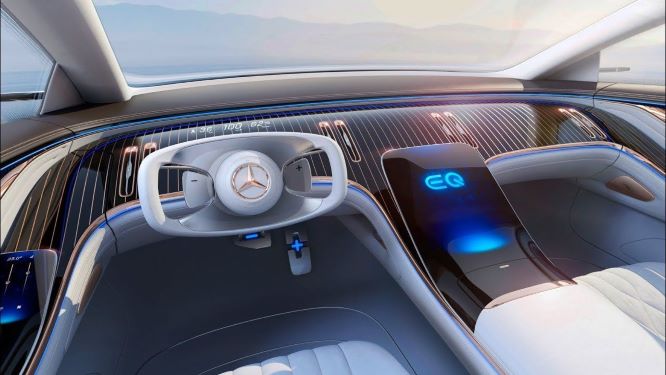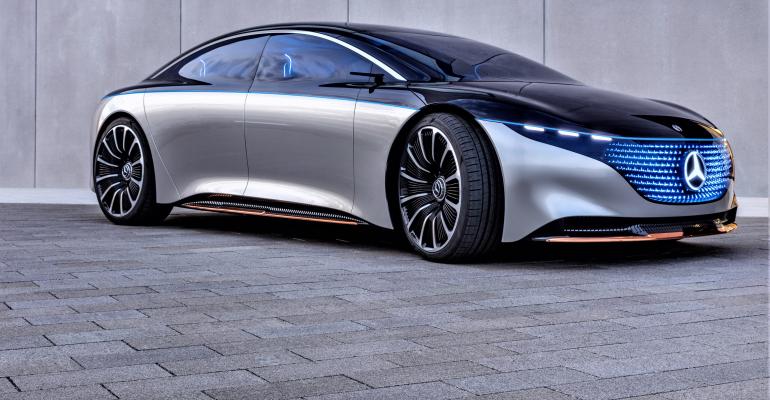Mercedes-Benz will launch its most ambitious electric model to date with the upmarket EQ S, and plans have emerged for an AMG version of the high-tech flagship that is planned to challenge the performance-car establishment with a 600-hp-plus dual-motor drivetrain.
The liftback-style limousine, coming to the U.S. market in early 2022, is the first EQ model to be based on the German automaker’s scalable EVA (electric vehicle architecture) – a skateboard-style structure that Mercedes-Benz says will allow it to offer unparalleled levels of accommodation among electric cars due to its flat floor and clever battery packaging.
Previewed by the Vision EQ S concept first shown at the 2019 Frankfurt auto show, the EQ S is planned to rival the new-generation Jaguar XJ due to reach showrooms next year; the Tesla Model S; Porsche Taycan; and several other luxury-car rivals being developed by EV start-ups, including the Lucid Air and XPeng P7.
The EQ S spearheads an “Electric First” strategy that Mercedes-Benz’s R&D boss, Marcus Schaeffer, says will see up to 50% of the company’s sales consist of so-called XEVs (both battery-electric and electrified hybrid models) by 2030, up from a projected 9% in 2020.
The EQ S will be the fifth dedicated EQ model from Mercedes-Benz after the EQ C, a midsize SUV on sale in selected markets since mid-2019; the EQ V, a commercial van-based luxury MPV; the EQ A, a compact CUV based on the second-generation GLA due for launch later this year; and the EQ B, a compact CUV based on the recently introduced GLB.
It will be the eighth battery-electric model to wear the EQ badge. The Smart EQ Fortwo, EQ Fortwo Cabriolet and EQ ForFour also belong to the sub-brand.
The flagship EQ model is distinguished from existing high-end Mercedes-Benz models by its unique short-hood proportions and monolithic body devoid of any feature lines. It will be sold alongside the seventh-generation S-Class to be revealed toward the end of the year with a range of new hybrid drivetrains prior to the start of North American sales in 2021.
Key among its exterior styling elements is a so-called black panel grille to be offered as an option. It will feature a three-pointed star motif similar to that showcased on the Vision EQ S, giving the new model what Mercedes-Benz designers describe as “an all-new face.”
The new grille is bookmarked by triangular-shaped headlights featuring optional digital light technology.
In another first, the EQS receives a fixed carbon-fiber, reinforced-plastic clamshell-style hood; functions such as the windshield-washer bottle filler are housed within the front fender.
Dimensionally, the production-version EQ S mirrors the existing third-generation CLS in length. However, the compact packaging of its electric drivetrain and flat floor are claimed to provide it with more interior space than the larger S-Class.
The highlight of its spacious cabin is a 45-in.-wide (114-cm) full glass screen (below) that houses a series of high-definition displays operated by a new MBUX user interface being developed in-house by Mercedes-Benz.
The automaker plans to offer the standard EQ S with a limited number of drivetrains, the most powerful of which, a dual-motor set-up, is expected to match the output of the earlier concept at 470 hp and 560 lb.-ft. (759 Nm) of torque in an initial EQ S550 4Matic-badged model.
It won’t be the most potent EQ S model, though.
Wards has learned Mercedes-Benz’s AMG performance-car division is set to enter the volume-production EV ranks with an even more powerful EQ S model with what one high-ranking engineer says are reserves equaling those of the existing twin-turbocharged 4.0L V-8 in the gasoline-powered S63 4Matic.
This points to the top-of-the-line EQ S, expected to be unveiled in 2022 prior to sales in 2023, offering over 600 hp and 663 lb.-ft. (900 Nm) of torque from a dual-motor setup.
By way of comparison, the most powerful existing Tesla Model S variant, the P100D, develops 764 hp and 722 lb.-ft. (979 Nm).
Nothing is official at this stage, though AMG is claimed to have signed off on a modular electric drivetrain strategy similar to that in place with its combustion-engine models. The likely scenario is that upcoming AMG versions of the EQ S, its smaller EQ E sibling and a high-riding model described as the EQ G could share the same high-performance drivetrain similar to how today’s “63” models use a common gasoline V-8.
According to one official familiar with Mercedes-Benz’s “Electric First” plans, the AMG drivetrain has been developed, in part, to head off a challenge from Tesla with its so-called Plaid drivetrain. While shrouded in secrecy, it is rumored to develop up to 800 hp and over 1000 lb.-ft. (1,3558 Nm) of torque in its ultimate form.
As showcased on the concept, the AMG version of the EQ S introduces an advanced all-wheel-drive system that varies the amount of power and torque delivered to each wheel.
The new AMG model will boast even more potent acceleration than the standard EQ S, which Mercedes-Benz already claims can accelerate from 0-62 mph (100 km/h) in 4.2 seconds. Unlike the existing EQ C, which is limited to 112 mph (180 km/h), its top speed likely will be pegged at 155 mph (250 km/h) in line with its performance-car positioning.
Energy for the EQ S’s electric motors is provided by a 100-kWh lithium-ion battery. Housed within its flat floor, it is envisioned to provide up to 435 miles (700 km) of range on the WLTP test cycle, although sources close to Mercedes-Benz suggest the real-world figure will be closer to 311 miles (501 km).
As with the Porsche Taycan, it will support 350-kW charging – a development that will allow it to be charged to 80% of its capacity in 20 minutes.





